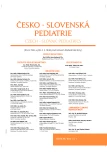Children born after assisted reproduction in the Czech Republic in 2013–2015
Authors:
A. Šípek jr. 1,2,3; V. Gregor 1,4; A. Šípek 1,3,4,5; J. Klaschka 6,7; M. Malý 6,8
Authors‘ workplace:
Oddělení lékařské genetiky, Thomayerova nemocnice, Praha
1; Ústav biologie a lékařské genetiky 1. LF UK a VFN, Praha
2; Ústav lékařské genetiky 3. LF UK, Praha
3; Oddělení lékařské genetiky, Sanatorium Pronatal, Praha
4; Centrum lékařské genetiky a reprodukční medicíny Gennet, s. r. o., Praha
5; Ústav informatiky Akademie věd České republiky, Praha
6; Ústav biofyziky a informatiky 1. LF UK, Praha
7; Státní zdravotní ústav, Praha
8
Published in:
Čes-slov Pediat 2020; 75 (1): 11-15.
Category:
Overview
Objective: Retrospective epidemiological analysis of representation of children born after assisted reproduction in the Czech Republic.
Methods: In this work we used data from the National Register of Reproductive Health from the Institute of Health Information and Statistics of the Czech Republic (IHIS CR) for the period 2013–2015. This National Register keeps registers of newborns, women, birth defects and assisted reproduction.
Results: In the period 2013–2015, 314,938 children were born in the Czech Republic after a spontaneous conception and 8,794 children were from pregnancy using assisted reproductive methods. When divided into children with congenital defect and without congenital defect, the differences between groups are very small – children with congenital defect after spontaneous conception 4.22% and after assisted reproduction 4.54%, children without congenital defect in group after spontaneous conception 95.77 % and after assisted reproduction 95.45%. In the distribution according to the frequency of pregnancy we found a higher proportion of children from multiple pregnancies in the group born after assisted reproduction (11.34%) compared to the group after spontaneous conception (2.81%). In the distribution according to frequency we found congenital defect in single dogs in 4.04%, and in children born from multiple pregnancies in 5.82%. Based on the type of concept and the frequency of pregnancy, we found more birth defects in children born from multiple pregnancies after assisted reproduction (8.62%) than in the spontaneous concept group (5.51%).
Conclusions: In the group of children born after assisted reproduction there is no statistically significantly more congenital defects as a whole than in the group born after spontaneous conception. However, in the group of children born after assisted reproduction there are more children born from multiple pregnancies – twins, triplets. Congenital defects occur more frequently in children from multiple pregnancies, but significantly more in children born from multiple pregnancies after assisted reproduction.
Keywords:
Czech Republic – assisted reproduction – congenital defect – Twins
Sources
1. Oborná I, Zbořilová B. Asistovaná reprodukce. Practicus (Praha) 2015; 14 (4): 16–18.
2. Kushnir VA, Barad DH, Albertini DF, et al. Systematic review of worldwide trends in assisted reproductive technology 2004–2013. Reprod Biol Endocrinol 2017; 15 (1): 6.
3. Žáková J, Ventruba P, Crha I, et al. Nové metody zvyšující úspěšnost asistované reprodukce. Čes Gynek 2012; 77 (2): 139–142
4. Sciorio R, Tramontano L, Catt J. Preimplantation genetic diagnosis (PGD) and genetic testing for aneuploidy (PGT-A): status and future challenges. Gynecol Endocrinol 2019; 18 : 1–6.
5. Levi Setti PE, Moioli M, Smeraldi A, et al. Obstetric outcome and incidence of congenital anomalies in 2351 IVF/ICSI babies. J Assist Reprod Genet 2016; 33 (6): 711–717.
6. Ericson A, Källén B. Congenital malformations in infants born after IVF: a population-based study. Hum Reprod 2001; 16 (3): 504–509.
7. Yang M, Fan XB, Wu JN, Wang JM. Association of assisted reproductive technology and multiple pregnancies with the risks of birth defects and stillbirth: A retrospective cohort study. Sci Rep 2018 May 29; 8 (1): 8296.
8. Šípek A, Gregor V, Horáček J, et al. Incidence vrozených vad u dětí z jednočetných a dvojčetných gravidit v České republice – aktuální data. Čes Gynek 2009; 74 (5): 369–382.
9. Řežábek K. In vitro fertilizace – rozbor údajů Národního registru asistované reprodukce za roky 2007–2011. Čes Gynek 2012; 77 (4): 336–341.
10. Jírová J, Zvolský M, Šípek A. Národní registr vrozených vad jako rozvíjející se prostředek evidence nejen vrozených vad v České populaci. Neonatologické Listy 2015; 21 (2): 32.
11. Glinianaia SV, Rankin J, Wright C. Congenital anomalies in twins: a register-based study. Hum Reprod 2008; 23 (6): 1306–1311.
Labels
Neonatology Paediatrics General practitioner for children and adolescentsArticle was published in
Czech-Slovak Pediatrics

2020 Issue 1
Most read in this issue
- It is never too late – HSV1-induced herepetic encephalitis
- Inherited arrhythmic syndromes in children
- Genetic causes of sudden infant death syndrome in the era of next generation sequencing.
- Expanded carrier screening of recessive disorders (CarrierTest) in clinical practice
